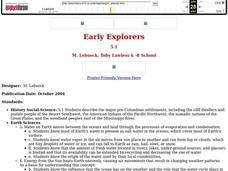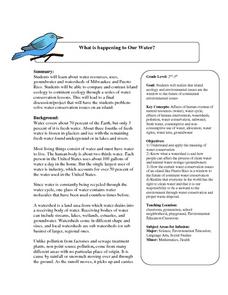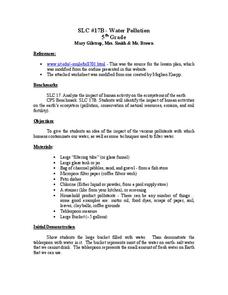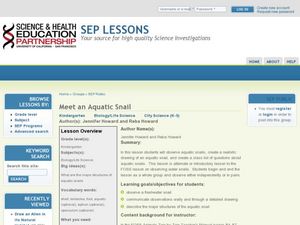Curated OER
The Caspian Sea
In this comprehension and geography learning exercise, learners read an article about the Caspian Sea, identifying where it is located and what countries surround it. Then they describe three parts of the sea, what are tributaries, and...
Curated OER
Examining Pond Life
Students collect and examine microscopic life from a local pond. In this biology instructional activity, students examine local pond water, searching for protozoa, with the use of a microscope. Students identify the various life forms in...
Curated OER
Food Webs in the Barnegat Bay
Students investigate the food webs in the Barnegat Bay. In this organisms lesson, students use a graphic organizer to illustrate the types of consumers in the bay. Students use reference books to continue to research the animals found in...
Curated OER
Trout Are Made of Trees Crayon Mural
Learners recognize that for a trout habitat to be ideal, several components must be present. In this trout lesson, students explore what makes a healthy stream. Learners create paintings for a mural of a trout habitat....
Curated OER
A Growing Success
Students create a multimedia presentation as a culmination of a plant unit. In this hyperstudio lesson, students research from assigned sites and create a Hyperstudio stack. Students write a cinquain.
Curated OER
Sea and Ice Salinity
Students conduct an experiment. In this salinity lesson, students learn about sea ice, why it is important and how changing amounts can affect the sea. Students conduct an experiment to find out the effects of salinity on the...
Curated OER
Sea Level and the Terrapin
Students study the habitat of the terrapin. In this terrapin activity, students create a diorama of the habitat of the terrapin. Students also simulate how it would look if people moved into the area and how predators can threaten...
Curated OER
Early Explorers
Fifth graders study early explorers. In this World history lesson, 5th graders draw an outline of a map labeling each part, build geographical features out of dough, and paint each of the land and water features.
Curated OER
Surface Water and Groundwater
Students examine distribution of water and minerals. In this surface and groundwater instructional activity, students conduct an experiment with fresh and salt water making hypothesis and drawing conclusions about minerals.
Curated OER
Brine Shrimp Hatching Experiment
Students hatch brine shrimp in a classroom experiment. For this hatching brine shrimp lesson, students participate in two-week lab in which they study how brine shrimp hatch under different conditions. They record data about the control...
Curated OER
Introduction to Restoration Lesson
Students explore how pollution and invasive plants disrupt the ecosystem. In this restoration instructional activity students list materials that pollute wetlands, how people can keep them clean and ways in which invasive plants...
Curated OER
Growth of a River
Students evaluate geography by drawing an image in class. In this river lesson, students identify a list of vocabulary terms associated with bodies of water. Students identify how a river is formed and draw a picture of one including the...
Curated OER
Plankton / Phytoplankton
High schoolers discuss the importance of plankton in the ocean ecosystem. In this biology lesson, students identify the different types plankton by observing them under the microscope. They explain how plankton population affect global...
Curated OER
Aqueduct Architecture: Moving Water to the Masses in Ancient Rome
Ninth graders compare ancient and modern technology in water transporting. In this lesson on the evolution of the aqueduct, 9th graders build a working aqueduct model and examine its components. They explain the importance and use of the...
Curated OER
A SALT WATER-Y WORLD
Students observe a model of the distribution of the earth's water and compare the relative volumes and percentages of types of water on earth.
Curated OER
Using A Winogradsky Column to Analyze Microbial Communities
Students use easily obtained materials to study ecological succession in a microbiological community. This investigation is appropriate for a variety of age groups. Elementary Students be fascinated by the changes occurring over time...
Curated OER
What is Happening to Our Water?
Learners compare and contrast Wisconsin's water resources to that of Puerto Rico. They research books about islands, particularly the Puerto Rican islands. Student view illustrations of island ecology. They discuss the illustrations and...
Curated OER
Water Scarcity in the Middle East
In this water scarcity worksheet, students respond to 11 short answer questions about water resource sharing after they read assigned textbook pages and the included article.
Curated OER
Volcano Above the Clouds
Young scholars develop a travelogue to describe the distinct ecological regions of Mount Kilimanjaro. They describe the health issues that may affect climbers, and any necessary equipment or safety precautions that the team may need at...
Curated OER
Snapshot Day Definitions & Activities
In this watershed worksheet, students read through related definitions and complete 17 short answer questions about deposition and erosion in the Hudson River.
Curated OER
Water Pollution
Fifth graders investigate how humans pollute the water supply with a number of different contaminates. While working in small groups they examine screening, sedimentation, filtration, and chemical treatments as methods of water treatment.
Curated OER
Meet an Aquatic Snail
Students explore aquatic snails. In this life science lesson, students create a class list of questions about aquatic snails and begin to observe aquatic snails in the classroom. Students record observations.
Curated OER
Saving the Bay
Students investigate water pollution prevention. In this ecology wastewater activity, students activate prior knowledge about sewage, then view a video explaining the waste water sewage system used in the San Francisco Bay area. Students...
Curated OER
Observing Brine Shrimp
Students observe brine shrimp eggs, create an appropriate environment for their survival, and observe their growth.

























